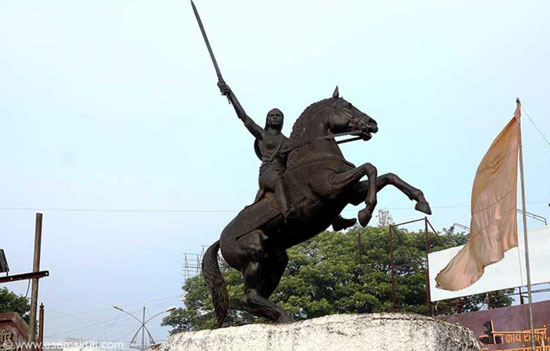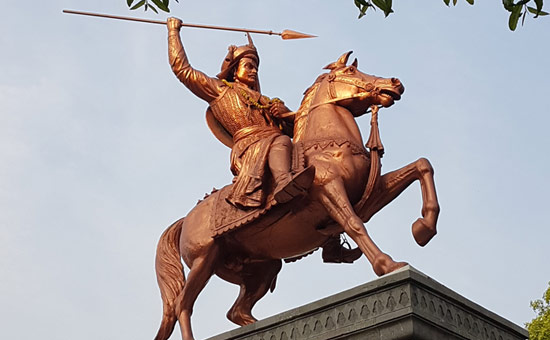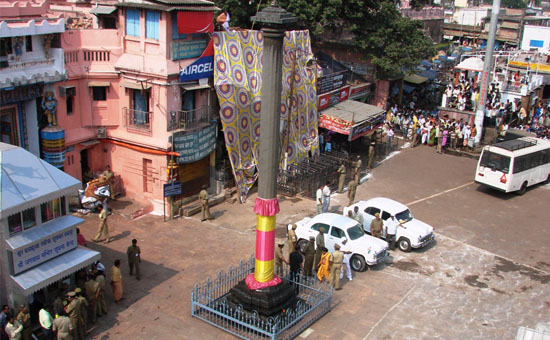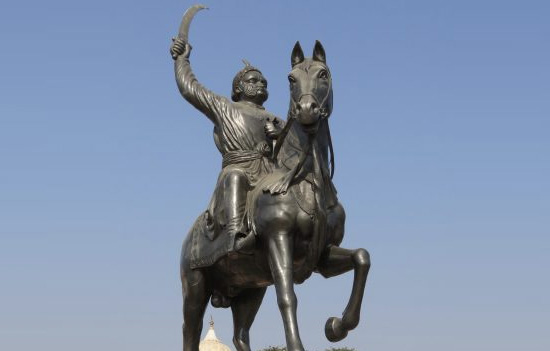- What were the reasons for the decline of
the Mughal Empire and what was the Maratha contribution? How did Marathas
acquire Bundelkhand, Malwa and Orissa and rise in the 18th century? Why did Abdali invade India?
Various reasons are put forth for the
decline of the Mughal Empire, the notable being the religious bigotry of
Aurangzeb and the weak successors (Jadunath Sarkar), Jagirdari crisis (Satish
Chandra, Athar Ali, J.F. Richards), Agrarian crisis (Irfan Habib), the Region-centric
approach (Muzaffar Alam) et al. 1
Though it is difficult to suggest a single
reason for the decline of the Mughal empire, the fundamental problem with the theory
of Jagirdari crisis is that its roots are elsewhere namely in determined Maratha
resistance and Rajput revolts during the reign of Aurangzeb and Bahadur Shah,
which will be discussed briefly here.
The decline of the Mughal Empire started
with Aurangzeb and for three reasons. One, religious bigotry. Two, unusually
long reign. His weak successors were only the outcome of this phenomenon. Three
and often most neglected cause is the success of indigenous resistance, the
most notable amongst them is the Maratha Empire. Like a phoenix emerging from
its ashes, the Maratha Empire was resurrected again by the end of 27 years of
war with Aurangzeb.
Also
read
Life
of Maharani Tarabai who fought Aurangazeb for 27 years
This article is a brief
review of events from 1707 to 1753, whereby in many parts of India, the Maratha
Empire replaced the Mughals. Since the primary focus of this article is on the Mughal-Maratha
clash, other theatres of war are not covered here.
 Maharani Tarabai (Kolhapur) took on Mughals after Shivaji Maharaj.
Maharani Tarabai (Kolhapur) took on Mughals after Shivaji Maharaj.
Phase
1 1707-1720
After the death of Aurangzeb, the war of
succession took place in two phases, the first was between Shah Alam and Azam
at Jajau. 2 The second phase is between Shah Alam and
Kambaksh, when the former marched towards Deccan and Rajput kings Jai Singh and
Ajit Singh. (this will be covered in part two)
The victory at Jajau in June 1707 and the
death of Azam allowed Shah Alam to advance towards Bijapur, where Kam Baksh was
placed by Aurangzeb, but he unexpectedly turned towards Rajputana. Alam not
only continued Aurangzeb’s policy of meddling in the succession of Rajput
kingdoms but took several steps forward. The policy of bringing these kingdoms
to Khalisa was baffling and many contemporary chroniclers had blamed Munim
Khan, the newly appointed Wazir, for the continuation of Aurangzeb’s Rajput
policy. The reason can be found in the so-called Jagirdari
crisis, which broke the back of the Mughal administration. 3
The provinces beyond the Narmada were not
useful for the Mughal treasury, also due to the expansion of the Maratha
Empire, so the question before Munim Khan was how to accommodate all the Mughal
nobles in the available area. He then forcefully pushed his argument to annex
the Rajput kingdoms and then redistribute these territories as fiefdoms to the
Mughal nobles, 4 which proves that the
‘jagirdari crisis’ has its roots in the determined resistance of Maratha and
other allied forces during 27 years of war with Aurangzeb.
Following the same strategy kingdoms like Kota
and areas like Gagron, Barod etc.were awarded by Shah Alam to Raja Budh Singh
of Bundi, who fought on Shah Alam’s side. 5
He also interfered in Amber, as Bijay Singh, the younger son of King Bishan
Singh had fought from his side, whereas King Jai Singh (II) fought from the
side of Azam at Jajau. Hence, under the garb of settling the dispute between
these two brothers, Shah Alam completely annexed the Amber in Khalisa (royal
lands) and the Mughal army was ordered to take control of it in January 1708. 6 After occupying Amber Bahadur Shah (Shah
Alam assumed this name) targeted Ajit Singh, who
only a year earlier recovered Jodhpur after a twenty-eight-year struggle and
had not joined either side during the battle of Jajau. Bahadur Shah sent Ajit
Singh Rathore (ruler of Marwar) a letter instructing him to return the kingdom
to his faujdar and submit to Mughal authority. 7
Also
read
Interesting
Facts about Bahadur Shah
Though as a tactical retreat kings Ajit
Singh and Jai Singh accepted Mughal suzerainty, as soon as Shah Alam marched
towards Bijapur to wage war against Kambaksh, both of them left the Mughal camp
and joined hands with Maharana Amar Singh II of Mewar (Udaipur). This resulted
in the opening of a new front for Mughals in Rajputana from 1707 to 1710, as the
combined army of three major Rajput states (Mewar, Amber, and Marwar) started
operations against the Mughal occupation of Amber and Jodhpur state. 8 To fan popular discontent, against
the Mughal rule, in other areas, Raja Sawai Jai Singh wrote letters to Hindu
kings like Chhatrapati Shahu and Maharaja Chhatrasal for their support.
As Bahadur Shah (ruled from 1707 to 1712) was
now marching towards Deccan for war against Kam Baksh, Raja Sawai Jai Singh hoped
that, if he (i.e., Bahadur Shah) battles against Marathas, then he will meet
the same fate as Aurangzeb. His letter to Chhatrapati Shahu who had just
assumed the command of the Maratha Empire reflects his confidence in the
ability of Marathas to defeat the Mughal army; a feat they had achieved only a
year ago.
“Your Highness is the Chief of Deccan. The honour of all the Hindus is one and the same. Hence you take such measures that just as by entangling Patshah Alamgir in the Deccan, the honour of Hindustan was upheld, in the same manner, this Patshah (Shah Alam) too should not be able to extricate himself from there.”9
The letter written to Maharaj Chhatrasal
echoes the same sentiment “You will
please join us early for the sake of the honour of the entire Hindu race. As we
all Hindus have common ties, you will not delay in coming towards our side’.
10 By 1709-10, army units were sent
towards Rohtak, Delhi, and Agra and outposts had been established in Rewari and
Narnaul. Letters were also written to Sikhs under Baba Banda Singh and Jats
under Churaman for their support. 11
This was the prime reason that Bahadur
Shah was keen on placating Rajputana as the growing power of Sikhs (expulsion
of Mughal occupiers in Punjab) and liberation of large tracts from Ravi to
Upper Ganga Doad by Banda Bahadur’s forces was a major concern for him. 12 Hence after defeating Kambaksh, he
hurriedly settled terms with the Rajput states and proceeded towards Punjab in
late 1710. He did not even stop at their capital Delhi. 13 However, Bahadur Shah failed to subdue Banda Bahadur and
ultimately died in a state of insanity after assuming the throne for merely
five years. 14
So, within these five years, Mughal Empire lost large parts of South India esp. parts Maharashtra (to Marathas)-Malwa, and Bundelkhand to Maharaja Chhatrasal. A large part of Punjab was under the control of Sikhs namely Banda Bahadur. With the restoration of Amber and Jodhpur to Maharaja Sawai Jai Singh and Ajit Singh by Bahadur Shah, the area actively controlled by the Mughal Kings shrank further.
The year 1719 was remarkable as in this
year, powerful nobles like Sayyid brothers started asserting themselves over
the Mughal king. In collusion with Maharaja Ajit Singh and Peshwa Balaji
Vishwanath (deputed by Chhatrapati Shahu), the Sayyid brothers killed Mughal
king Farrukhsiyar (ruled 1712 to 1719) and placed their pawns Rafi-ud-Darajat
and later Rafi-ud-daulah (elder brother of former) on the Mughal throne. 15 For helping Sayyid brothers in this
palace coup, the right to levy Chauth (25% of produce) over six Deccan
provinces were handed over to Chhatrapati Shahu in 1719.
This was the starting point
when the Mughal Empire began to crumble in earnest. 16 In the same year, Maratha general Pilaji
Gaikwad entered Gujarat and defeated Mughal forces near Surat and liberated
areas like Songad, Dabhai, which became the Maratha bases in the subsequent
liberation of Gujarat from Mughal occupation. 17
Also
read
About Pilaji
Gaikwad, considered founder of Gaikwad dynasty of Baroda
 Bajirao Peshwa never lost a battle in his 40 years. Pic by Uday S Kulkarni.
Bajirao Peshwa never lost a battle in his 40 years. Pic by Uday S Kulkarni.
1720-1740
These two decades saw the rise of Peshwa
Bajirao and the expansion of the Maratha Empire all over India. From 1724 to
30, Marathas were gradually increasing their reach by liberating areas like
Indore (Malharrao Holkar), Dhar (Udaji Pawar). This was achieved with the support
of Sawai Jai Singh and local sympathizers like Rao Nandlal Mandloi and Thakur
Anup Sing. 18
Also read About
Malhar Rao Holkar and see Fort
of Dhar
In early 1728, Nizam was defeated by
Bajirao at the Battle of Palkhed. (called a ‘masterpiece of strategic mobility’
by modern Generals like Bernard Montgomery). 19 By the treaty of Mungi-Paithan, Nizam agreed that Chhatrapati
Shahu was the ruler of the Maratha Empire (thus not fuelling the internal
conflicts by helping the Chhatrapati Sambhaji of Kolhapur against him), not
interfering in the six provinces of the Maratha Empire, and gave back areas
captured in Maval region of Maharashtra. 20
In the later part of 1728 the pact of friendship and mutual cooperation, which was forged between Chhatrapati Shivaji Maharaj and Maharaja Chhatrasal in the 1670s, was put to test when Muhammad Bangash attacked the latter’s domains. Even after fighting for a year, Bundela’s were not able to completely evict Bangash from their domains, hence a call was given to Marathas for help as brothers in arms. The timely help to Raja Chhatrasal from Bajirao Peshwa earned him many laurels, including a one-third portion of Bundela kingdom which became a base for future operations toward Delhi. 21
 Chimaji Appa. Pic by Uday S Kulkarni.
Chimaji Appa. Pic by Uday S Kulkarni.
Also
read
Baji-Rao,
the Empire Builder
During 1724 to 1726, Maratha nobles like
Kanthaji Kadam, Pilaji Gaikwad and Trimbakrao Dabhade forced the Mughal subedar
of Gujarat, Sarbuland Khan to cede the rights of Chauth collection near Mahi
River to Marathas. By 1732 Mughals had to cede further ground to Chimaji Appa
(younger brother of Bajirao) by giving rights to collect Chauth and
Sardeshmukhi from all of Gujarat. 22
Also
read
The
extraordinary exploits of Chimaji Appa
As the Marathas started gaining in areas
of Gujarat, Malwa, and Bundelkhand directly threatening Delhi, King Muhammad
Shah ordered a campaign against them.
From 1734 to 36, many small and medium
scale battles were fought between Mughal and Maratha armies in places like
Gwalior and Orchha. In 1736 a grand campaign was planned against the Marathas for
which the Nizam was called from the Deccan.
In early 1737, one army unit under Holkar
was defeated by the forces of Sadat Khan and Safdar Jung, near Koil but they
mistook this as a victory over the main Maratha army of Bajirao Peshwa. They
camped near Mathura with Khan Dauran and Muhammad Bangash, and sent letters
boasting about this ‘spectacular feat’ to Muhammad Shah. Bajirao decided to
teach them a lesson and marched like lightning, bypassing them straight towards
Delhi. The speed was such that the distance which requires ten days to cover
under normal circumstances, was covered in just three days by the Maratha army.
23
This was the first direct Maratha
attack on Delhi
(unlike 1719 when they were teamed up with the Sayyid brothers and Maharaja
Ajit Singh Rathore). The shocked Mughal army of Amir Khan marched out of Delhi
but had to retreat with heavy losses when their top commanders like Mir Hasan
and Raja Shiv Singh were killed. However at this time, Bajirao was there, to
show that Maratha power was still intact, not to sack Delhi.
A letter sent to his brother Chimaji
confirms that he was looking for gradual expansion of Maratha power in areas
like Gujarat, Bundelkhand, Malwa and the seal of approval of the Mughal king can
be achieved through a combination of battles and diplomacy. Destruction of
Delhi would ruin the delicate diplomatic manoeuvres. Hence, after this show of
force Bajirao returned to the Deccan. 24
In late 1737, Nizam marched from Delhi
with the aim to oust the Marathas from newly liberated areas like Malwa and
Bundelkhand, but he was trapped near Bhopal by Bajirao Peshwa. Maratha nobles
like Malharrao Holkar, Ranoji Shinde, and Yashwantrao Pawar harassed the Nizam
from all sides by cutting his supplies and foiling any breakout attempt. The
relief force from Aurangabad was blocked by Chimaji Appa and the Mughal army
under Shujaet Khan was defeated near Elichpur by Raghuji Bhonsle of Nagpur,
preventing any help from reaching the Nizam’s trapped forces. After the siege
of about one month, when it was clear that no relief was forthcoming, finally, the Mughal forces under Nizam surrendered. 25
The treaty of Bhopal confirmed the
Maratha supremacy over Malwa and Bundelkhand. The grant on paper was later
released in 1741-43, thereby King Muhammad Shah gave Malwa to Marathas. 26
This treaty marked the transformation of
the Maratha State and is important because the territory expansion of Marathas
in Bundelkhand and Malwa were confirmed when Mughal king released the grant of
these areas to Marathas.
 Arun Stambh at Puri Temple. It was brought here from Sun Temple Konarak during Maratha rule in 18th
century. Pic by Rabi Sahoo.
Arun Stambh at Puri Temple. It was brought here from Sun Temple Konarak during Maratha rule in 18th
century. Pic by Rabi Sahoo.
1740-1753
After the death of Bajirao, his son Balaji
alias Nanasaheb became the Peshwa of the Maratha Empire. Chhatrapati Shahu
Maharaj distributed areas to be conquered between Nanasaheb and Raghuji Bhonsle
of Nagpur. The responsibility of liberation of major areas like Bihar, Bengal,
and Orissa was given to Raghuji whereas, the Ajmer, Agra was under Peshwa. 27
From 1742 onwards, the Maratha army under Bhaskar
Ram (Senapati of Maratha army of Raghuji Bhosale of Nagpur) liberated the
areas of Chattisgarh and started attacking Orissa, and Bengal. The Mughal army
of Aliwardi Khan was defeated at various places including Katwa. Major cities including the capital Murshidabad were
sacked by joint forces of Mir Habib and Marathas. To halt these yearly Maratha
attacks, Aliwardi Khan called Bhaskar Ram to a meeting and killed him along
with 21 prime nobles at Mankura in March 1744. 28
But the treachery and murder of Maratha
nobles had the exact opposite effect on Raghuji as he continued the attacks for
taking revenge. Aliwardi tried to divide the Maratha power by asking for help
from Nanasaheb Peshwa. However the two Maratha chiefs soon reconciled their
differences in the presence of Chhatrapati Shahu and the Raghuji was free to
continue his conquests.
Finally, in 1751, the treaty was signed
between Raghuji and Aliwardi, whereby Orissa was
recognized as the part of Maratha Empire and regular Chauth of Bengal and
Bihar was agreed to be given to Marathas. 29
The reason later Mughal kings struggled financially and were unable to raise large armies like their predecessors has roots in these conquests. The fertile, and large revenue-yielding areas like Malwa, Gujarat, and Orissa, were taken over by the Marathas, and areas in the northwest were looted by Nadir Shah. The province of Agra was now under the command of Maharaja Surajmal and the various Rajput kingdoms were acting independently thus depriving the wealth and manpower of the Mughal Empire.
Also read When
Marathas rejuvenated Orissa
The death of Nadir Shah in 1747 and Abdali
declaring himself the king of Afghanistan had long-term consequences for India.
The rich province of Punjab lying on the eastern periphery was a lucrative
prospect for him, especially when the Mughal kingdom was in such turmoil. Even
though his first attack on Punjab ended in tactical failure (Defeat at the
Battle of Manupur-1748), strategically the balance shifted soon in his favour
as Rohila-Pathans who were now settled in India, tried to revive the dream of
earlier sultanates like Khilji and Lodi dynasties by allying with Abdali. 30
The war took a religious dimension as
Wazir Safdar Jang (Shia) was sent against Rohilla leaders like Ahmed Khan
Bangash, Najib, Hafiz Rehmat Khan (Sunni). Sensing this danger, Wazir Safdar
Jang had no choice but to call the Marathas for help. 31
During this war, when Pathans were hard-pressed
fighting the armies of Safdar Jang and Marathas in late 1751- early 1752. The
attack of Abdali on Punjab shows the level of coordination between him and his
Indian Rohilla allies. 32 Safdar
Jang hastily concluded the treaty of Lucknow in February 1752 with the battered
Rohilla chiefs and half the territory of Bangash from Koil to Kora, with a
yield of 30 lakh rupees, was transferred to the Marathas. This became the
permanent base of Marathas in the Ganga-Yamuna doab. 33
 Maharaj Surajmal of Bharatpur.
Maharaj Surajmal of Bharatpur.
Ahadnama
(Treaty of protection)
Meanwhile, Abdali marched up to Lahore and
defeated the Mughal governor Muin-ul-Mulk. The news of this defeat sent shock
waves in the Delhi court. King Ahmad Shah sent a farman, in his own hands, to
Vazir to come with a strong Maratha force to Delhi to counter this threat.
The treaty of protection was signed
between Mughal king (through Safar Jung) and Marathas at Kannauj and is popularly known as Ahadnama, which gave Marathas the right to collect taxes from
northwest provinces like Multan and Sindh and Subhedari of provinces like Agra
and Ajmer.
The most fundamental irony in this
situation was that Aurangzeb spent his last 27 years in Deccan to crush the
nascent Maratha Empire but within 5 decades of his death, his successors had to ask for protection from the same
Marathas from internal as well as external enemies like Abdali. 34
Some modern-day historians and social
media warriors scoff at this and term Marathas as ‘tax collectors of the
Mughals’. Surprisingly for them Britishers were ‘shrewd’ and ‘farsighted’ when
they employed the same policy, merely a dozen years after this treaty; becoming
‘tax collectors’ in fertile lands like Bihar and Bengal, and then using the
collected revenue to expand their armies and ultimately dominate the Indian
subcontinent. The trajectory of the
Maratha Empire would have been the same had two major events not intervened ruining
their plans.
Part II will be continued from 1754
onwards.
To read all
articles by author
To read excerpts from Author's book on Aurangzeb
Also
read
1. Shivaji’s
Karmas matter, not caste
2. Life
of Mahadji Scindia
3. Pilajirao
Jadhavrao – A brave Subedar
4. Battle
of Salher whose loss depressed Aurangzeb
5. Return
of Queen Yesubai
6. The
untold story of Maratha History – Videos by Col Anil Athale retd
7. About
Maharaja Surajmal of Bharatpur
References
1. Anjali Yadav, Decline of the Mughal
Empire, BHU. Pg. 7-9.
2. V.S Bhatnagar, Life and times of
Sawai Jai Singh, Pg. 35, 1974.
3. M. A. Ali, The Mughal nobility under Aurangzeb, Pg. 92-93. 1970.
4. V.S.Bhatnagar, Life and Times of Sawai Jai Singh, Pg. 41-42. 1974.
5. Ibid, Pg. 40
6. Ibid, Pg. 48, 49.
7. Ibid, Pg. 50.
8. Shyamaldas, Vir Vinod-Volume-2,
Part-2, Pg. 770, 1986.
9. V.S.Bhatnagar, Life and Times of Sawai Jai Singh, Pg. 59. 1974.
10. Ibid, Pg. 64.
11. Ibid, Pg. 62-63.
12. Hariram Gupta, History of the
Sikhs-V-II, Pg. 16.
13. Ibid, Pg. 17.
14. Ibid, Pg. 22.
15. G.S. Sardesai, Marathi
Riyasat-1707-40, Pg. 90-92, 1925.
16. G.C. Vad, Treaties, Aggrements
& Sanads, Ed-Mavjee & Parasnis, Pg. 1-9, 1914.
17. G.S. Sardesai, Marathi
Riyasat-1707-40, Pg. 219, 1925.
18. Ibid, Pg. 322-31.
19. Gen. B. Montgomery, A concise
history of warfare, Pg. 132, 1972.
20. G.S. Sardesai, Marathi
Riyasat-1707-40, Pg. 196-97, 1925.
21. G.Tiwari, Bundelkhand Ka Itihas, Pg. 232. 1933.
22. G.S. Sardesai, Marathi
Riyasat-1707-40, Pg. 222-25, 1925.
23. Ibid, Pg. 360.
24. Ibid, Pg. 364.
25. ibid, Pg. 371-73.
26. R. Singh, Malwa in Transition,
Pg. 322.
27. Y.M. Kale, Nagpur Prantacha Itihas,
Pg. 93, 1934.
28. Ibid, Pg. 95
29. Ibid, Pg. 98
30. A.L. Shrivastava, The first two
Nawabas of Oudh, Pg. 124, 1933.
31. Ibid, Pg-177. & G.S. Sardesai, Marathi
Riayasat-Part 6, Pg. 206-7, 1953.
32. A.L. Shrivastava, The first two
Nawabas of Oudh, Pg. 177, 1933.
33. Ibid, Pg. 188-89
34. Ibid, Pg-200-01, for details, V.K.
Rajwade, Sources of Maratha History-Vol-1, Pg. 1-10.